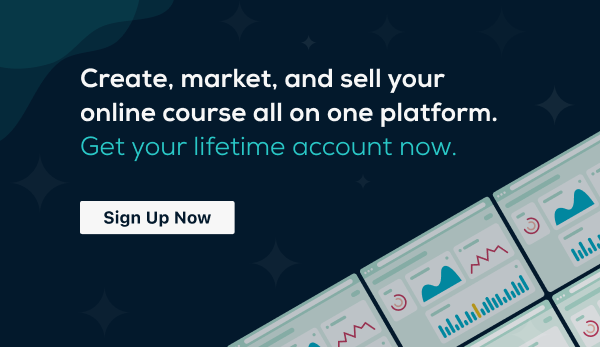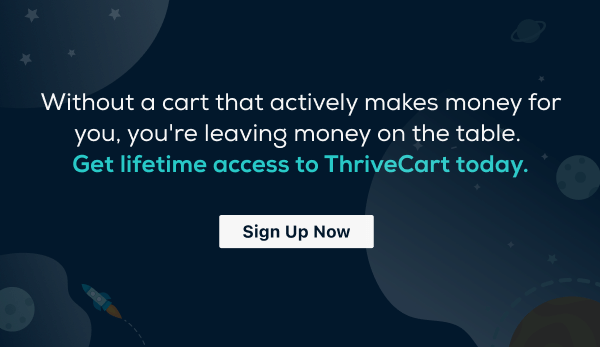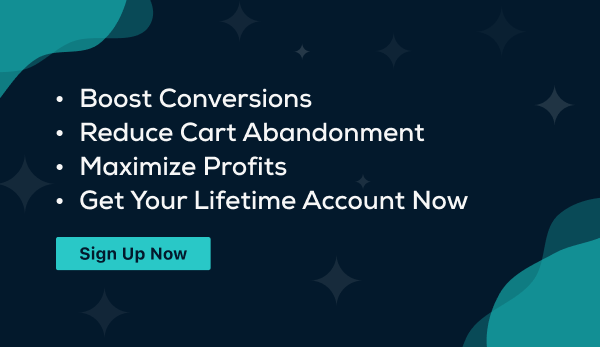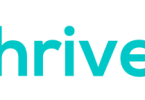Creating an online course can be a great way to establish yourself as an authority and earn money when you sell online courses. However, developing the course is just the beginning.
After publishing, you need to market online courses to learners. Creating a digital marketing strategy enables course creators to find and target your ideal learners. Online course marketing is an essential step for entrepreneurs to generate leads, gain referrals, and build a customer base.
In this article, we’ll cover the basics of marketing for online courses to recruit and attract learners, marketing strategies for lead generation, and proven methods for increasing conversions.
Online Marketing 101: The Basics
Your marketing strategy will encompass all of the tactics you employ to generate leads, connect with your target audience, and convert them to buy. Marketing campaigns can include strategies such as:
- Email marketing
- Social media marketing
- Content marketing, including guest posts
- Website and landing page optimizations
- Paid ads (Search ads, Facebook ads, etc.)
- Influencer marketing
- Affiliate marketing
Every buyer goes through a buying journey that’s known as the AIDA marketing funnel (Attention – Interest – Desire – Action). While the following explanation is not intended to be a complete guide, it illustrates how marketing strategies should be framed to capture learners for your online course.

- Attention: At the top of the funnel, the goal is to grab the customer’s attention and make them aware of your courses and the need. Efforts in this area typically focus on pain points and problems that your course will help solve or the advantages it will provide.
- Interest: Once the customer is aware of your product or service, the goal is to spark their interest and provide more information that will keep them engaged. Providing social proof and gaining trust is essential.
- Desire: At this stage, the goal is to create a desire for the product or service by showing the customer how it can help them meet their goals.
- Action: The goal here is to motivate the customer to take action and sign up for your online courses. You need a strong call to action encouraging learners to sign up now.
How To Market an Online Course
To market an online course, you want to make sure you are taking the right actions at each stage of the marketing funnel. Tailoring your marketing approach as buyers move through these stages can help improve your results.
You’ve got some work to do and likely a fair amount of competition. So, you will want to make sure your online presence is in order and then aggressively promote your online courses. Here are 11 marketing strategies that can help you market your online course and sign up learners.

1. Learn and Implement SEO
Search engine optimization (SEO) is the practice of optimizing a website and online content to showcase its topical expertise and improve its visibility on search engines like Google. This allows your website content to achieve high-ranking positions on search engine results pages (SERPs).
Google’s algorithm uses hundreds of different signals from content to decide which websites and pages best meet searcher intent. Here are a few of the key things you will want to consider to optimize your online courses and marketing materials:
- Keyword research: Finding the terms that people use to search for information related to your course offerings. An easy way to do this is to use Google’s free Keyword Planner Tool.
- On-page optimization: Website and landing pages should be customized to match course content. This includes using appropriate semantic terms and optimizing page titles, meta descriptions, headings, and other tags.
- Link building: When you can acquire links from other high-authority websites, it signals to search engine algorithms that others value your content. These backlinks improve your website or landing page’s authority and search ranking.
- Content creation: Publishing relevant, informational, educational, and valuable content for your target audience helps with discovery and can boost your website’s rankings in search.
- Technical SEO: You will also want to make sure your website or landing page is optimized for technical SEO. This includes things like site navigation, loading speed, site architecture, security, and mobile-friendliness.
Employing best practices for SEO can make a significant difference in getting found online. This is crucial to stand out amid the six million blog posts added to the internet every day, not including all of the new websites and social content.
2. Promote on Social Media
Social media is powerful for selling online courses. Depending on the type of courses, different social media platforms may work better than others. For example, if you are selling a course to business professionals, you may get better results on LinkedIn. If you are selling a consumer-focused course, Facebook, Twitter, and Pinterest may yield better results. For students and younger people, Instagram and TikTok may be the place to be.
The key to making social media pay off is to be consistent and create meaningful content with a strong call to action to attract potential leads and get students enrolled.
Don’t overlook the power of video, either. YouTube is the second-largest search engine and the second-most frequented social media platform. You can create videos on YouTube for free and also post them on your social media accounts. You can also create YouTube videos and channels and attract subscribers.
One effective strategy to leverage social media is to find target audiences that fit the profile of your online learners. You can often find them in Facebook Groups, YouTube channels, and online forums that target the same groups.
3. Create and Promote a Free Mini Course
Another effective digital marketing strategy for online instruction is to create a free mini-course as an introductory offering. This gives potential learners a free sample of what they’ll get.
It also helps establish your authority and can introduce students to your company, instructor(s), and course materials. Once they see the professionalism of your online courses and get an overview of the course topics, it can encourage students to pay for your course.
Many brands have used this strategy to sell online courses or subscriptions to ongoing lessons. For example, motivational speaker Tony Robbins offers free courses on his website to introduce his coaching methodology and personal development programs. These mini-courses are designed to inspire viewers to sign up for paid programs.
Many of the online MOOC (massive open online course) platforms also use this approach, as does HubSpot Academy. HubSpot offers a free mini-course on email marketing that covers the basics, then invites users to sign up for their advanced courses, email marketing certification courses, and software solutions.
ThriveCart’s Learn and Learn+ platforms are a great option for creating and hosting your free mini-course.
4. Include Testimonials
Approximately 92% of consumers read online reviews before making a purchase decision. When you display testimonials on your website or landing page from happy customers, potential learners can see how your course has impacted others, and the results they’ve gained.
Using testimonials as a form of social proof provides several benefits, including:
- Building trust: Those unfamiliar with you may be hesitant to sign up for your course. When they see others have done so successfully, it helps alleviate their concerns.
- Overcoming objections: Testimonials can also address some of the objections that potential students might have. For example, if someone is concerned about the quality or value of a course, hearing that previous students found it valuable can help overcome their objection.
- Demonstrating results: One of the best uses of testimonials is to demonstrate tangible results from others that have completed the course. You might highlight someone that learned skills to get a promotion or a new job, or start a career.
Depending on the type of learner you’re trying to attract, different approaches to testimonials will work better than others. Students looking to start a career may want to see how others took your courses and got great jobs. Business executives may want to see tangible results in the form of a case study from those taking your course. For example, a business leader who took the course and was able to improve productivity by a specific percentage.
5. Provide Discount Codes and Promotions
Every consumer enjoys a deal, and potential customers for online courses are no exception. Discount codes and promotions can help attract new customers, especially limited-time offers that inject a sense of urgency into signing up..
When offering discounts, though, course creators must balance them against impacting overall profitability or devaluing the brand.
As an example, Udemy often offers online courses at discounted prices, sometimes as low as $9.99. This has helped the platform attract a wider audience and work as an introduction to online learning. Meanwhile, MasterClass offers courses and subscriptions but does not discount them as a way to position itself as a premium offering.
Both approaches can work well, depending on the course content and value. Discounts can attract price-sensitive customers and increase sales volume. Not offering discounts can help maintain a prestigious brand image and attract customers willing to pay higher costs for high-quality courses.
6. Use Online Advertisements
Online ads are another effective way to get the word out and expose your online courses to a wide variety of potential students. Ads on search engines and social media platforms are generally quite effective.
- Social media and search engine advertising provide targeting tools that let you show ads to specific audiences, such as education level, household income, job titles, interests, and location.
- Targeting features available through Google Ads, Facebook Ads, and YouTube Ads can ensure you reach the ideal audience for your course content, and achieve the highest possible ROI on your ad spend.
- Retargeted marketing campaigns reach people who have already visited your website’s landing pages or sales pages. You can create ads that are shown to them as they visit other websites online.
- A/B testing your ads allows you to test various combinations of ads to see which works best, which then allows you to optimize the performance of your campaigns. For example, Google search ads let you test up to 15 headlines and four descriptions, automatically running tests on different combinations to find which keywords and phrases generate the most leads.
7. Implement a Lead Magnet
A lead magnet can take various forms. Typically, it’s a piece of content, such as a webinar, eBook, checklist, case study, or another piece of content you provide free of charge in exchange for collecting email addresses or phone numbers. A lead magnet is designed to attract customers by providing them with something of value. In return, they provide contact information so that you can market to them.
Lead magnets can help your sales funnel by attracting potential customers that are not yet ready to purchase your online course. As mentioned earlier, giving them a bit of information for free helps establish your authority on a topic and build trust, making them more likely to convert to buyers or subscribers. Once you have their contact information, you can continue to nurture them as they progress through the sales funnel, building interest in your online courses, and increasing the likelihood of signups to sell online courses.
As it stands, 61% of businesses report that lead generation is their biggest challenge. Lead magnets are an effective way to generate leads and market your online courses. People responding to your lead magnet have an interest in the topics you cover, so they are more likely to be interested in your online courses.
Once you’ve gotten potential customers to your site, you can also use a tool like ThriveCart to assist in sales funnel optimization and maximize your opportunities.
8. Appear on Podcasts
Podcasting has become a popular pastime. There are nearly two and a half million podcasts listed on the Apple platform, with dozens of additional podcast platforms available. Nearly two-thirds of people living in the U.S. say they have listened to podcasts and more than a quarter say they listen to podcasts weekly.
Hosting a podcast or appearing as a guest on a podcast are excellent options for speaking directly to an audience and highlighting the benefits of your online course, mentioning its fundamentals, the instructor’s experience and hard-earned know-how, and the overall value of the course.
Finding the right podcast that reaches your target audience or securing an engagement as a guest host or interviewee will take some work. Before you can get booked, you’ll want to make sure you have a robust online presence to help establish your credibility.
You will want to search online for podcasts that target the audience you’re trying to reach and then contact them directly. Be sure to craft an effective pitch that introduces yourself and your courses, and explain exactly what you can talk about and the value you can bring to their audience. It helps if you can share your opinions or expertise on a trending topic or news item, as the hosts will be eager to offer their listeners an interesting point of view.
9. Host Live Webinars and Online Events
On the topic of sharing your expertise, if you can’t find a podcast to jump in on, you can consider hosting your own event. Live webinars and similar online events can attract your target audience by providing insightful and actionable information. You can speak to what you know, which helps establish your credibility while providing attendees with valuable information. All throughout, you can promote your online course and describe its benefits.

When considering a webinar, there are several key steps you need to take, including:
- Planning: Identify the right topic and audience for your webinar. Choose a date and time, the format and content, and set up registration.
- Creating: Create a slide deck, digital handouts, and any other materials that you want to include. You’ll need to make sure you have the technical capability to handle the webinar and practice it so you’re ready to go.
- Marketing: If you want people to attend, you have to let them know about it! Promote your webinar through email marketing, social media, and other channels to attract attendees. Use targeted messaging to encourage people to register and let them know what they’ll get when they attend.
- Hosting: Make sure your technical equipment is in place, you have a solid internet connection, and everything is ready to go.
- Post-webinar follow-up: After the webinar, follow up with attendees to thank them for attending. You may want to offer a recording of the webinar or links to related content. Follow-up is a great time to invite attendees to sign up for your online course if they haven’t done so already, or provide a discounted sign-up code for those who had attended your event.
10. Create an Email Marketing Strategy
Despite the high volume of email people get every day, email marketing continues to produce significant results. 29% of marketers say email marketing is their most effective channel for driving conversions, surpassing social media, SEO, and content marketing. Email marketing is a great way to build a community, announce sales, promote newly launched courses, highlight upcoming events or webinars, and generally keep people interested in your offers.
The most effective email marketing strategy is to build email marketing lists from your lead magnets and lead-generation strategies, such as webinars and landing pages. While you can buy email lists online, when your list comes from people that have already made a connection with you through one of your lead-generation funnels, you increase the likelihood of conversion significantly.
Your email marketing strategy allows you to personalize messages to specific target audience segments to make your outreach even more effective. There are inexpensive marketing automation platforms that can help you segment your audience and personalize email at scale for your e-learning or online classes’ marketing efforts.
For example, someone that put your online course in their shopping cart but then didn’t make the purchase is ripe for an email inviting them to consider returning to complete the signup. ThriveCart lets you automate cart abandonment emails and include a personalized message or even include an extra incentive for conversions.
11. Create an Influencer Affiliate Program
Affiliate marketing is big business, generating more than $17 billion annually. More than 80% of companies and advertisers use some form of affiliate marketing, accounting for as much as 16% of overall sales.
As such, affiliate programs are a fantastic option for marketing your online courses. By working with bloggers, influencers, and micro-influencers who have already built a following in your niche, you can leverage their influence to gain exposure for your online courses .
In a standard affiliate marketing partnership, influencers share the value of your courses and offer a special promotion for their followers. Those affiliates then receive a commission for any new sign-ups attributed to their promotional efforts.
How ThriveCart Can Optimize Your Online Course Sales
Aggressively marketing your online courses with a proactive strategy can help improve your results and help you to sell your online courses.
Once you get someone’s attention or capture a lead, you need a high-converting sales funnel for digital products that will turn leads into paying customers. Thrive Cart can help learners sign up and make it simple for them to purchase your courses.
In fact, the ThriveCart Learn platform allows course creators to create and host online courses in one place. ThriveCart Learn is free as part of your standard ThriveCart account, allowing for unlimited courses, modules, lessons, sessions, and students. You can create any number of projects you want, keep them all organized in one platform, and simplify your sales and delivery. You also get tools to manage students, monitor status, sort and filter, enroll or unenroll, and more.
ThriveCart Learn+ is an advanced version that contains additional features, such as bundles to sell multiple courses. You can also enable team members to provide staff or assistants to access and manage your projects.
Using ThriveCart makes it simple to manage and maintain your courses, sign up students, and collect your payments, simplified in a centralized platform to do it all. Users see a boost in conversions and streamlined management to help increase sales. See how easy it can be to manage and market your online courses by signing up for ThriveCart today.







